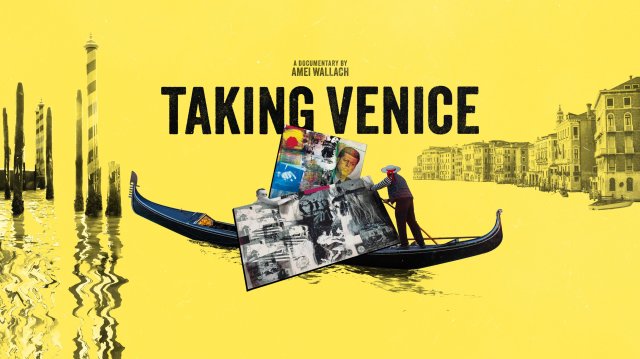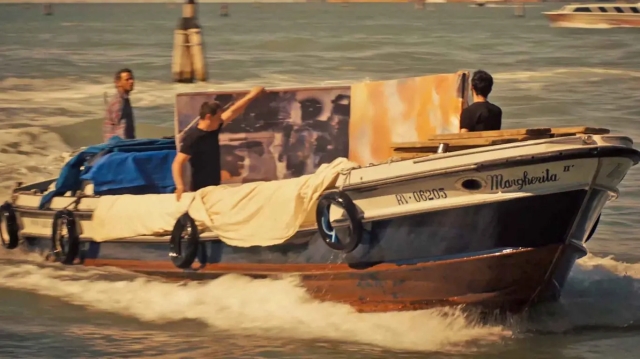
Review: The New Documentary ‘Taking Venice’ Combines ‘Combines’ and Cold War Conspiracies: “You can’t fault Taking Venice for its timing. Its theatrical release comes just weeks after the opening of the 2024 edition of the Venice Biennale, at a time when the U.S. is on a run of critical successes and public acclaim for its national pavilion curations. … It’s also the 60th anniversary of the tongue-wagging events investigated in director Amei Wallach’s newest art world documentary. Going into this film you learn, for the first time, perhaps, that rumors have persisted since 1964 alleging that the U.S. government, specifically its military and spy agencies, had meddled in the prize-giving in Venice — and, in a broader sense, had weaponized the excitement around contemporary American art for use in Cold War cultural propaganda. To this end, all sorts of wealthy and well-connected players had, allegedly, bullied and colluded to ensure that the American artist Robert Rauschenberg would win that year’s top painting prize. Which he did. Ultimately, the film, with its earnest protestations and well-informed contextualization of the events surrounding 1964 — many in the form of confident first-person narratives by people who were there when it all went down — presents plausible cases for various interpretations of events. For example, the idea that Alan Solomon, who brought Robert Rauschenberg to wide acclaim by curating his solo exhibition at the Jewish Museum in New York, in 1963, and who worked closely with Rauschenberg’s dealer, the Italian-born mega-gallerist Leo Castelli, would energetically champion a win for the artist on the art world’s biggest stage — that makes total sense. The optics of the work arriving in Italy on a U.S. Army transport plane … less so. That happened because Alice Denney, the Washington insider and friend of the Kennedys who had recommended both Solomon and Castelli, was married to a high-ranking intelligence official within the U.S. Information Agency who oversaw the Biennale entry through its fine arts division — which, by the way, is a thing that existed. Denney was invested, not only as a supportive and adventurous art collector but as a matter of international cultural diplomacy. So when funds fell short for transporting Rauschenberg’s large-scale works overseas, she simply borrowed a plane from the Army. Nothing to see here! Extensive details on the contentious meetings of the Biennale’s jury in the lead-up to the eventual vote provide many of the most entertaining passages of the film, with richly recollected parties, lobbying sessions at Cafe Florian, in Piazza San Marco, rather gauche advertising campaigns, and operatic threats between and among the prize committee jurors. At one point, the entire Merce Cunningham Dance Company’s world tour is diverted to Venice — with Rauschenberg acting as its costume designer — for a sold-out performance at the historic Teatro La Fenice, which, by all accounts, moved the ball in the artist’s favor in the final hours before the Biennale opened. …”
Voice (Video)
Taking Venice (Video)
Zeitgeist Films
Bill Davis
-
Join 427 other subscribers
Tags
- 1968 DNC
- Agent Orange
- Alan Watts
- Allen Ginsberg
- Angela Davis
- ARVN
- Berlin Wall
- Bill Graham
- Black Power
- Bob Dylan
- Books
- Burroughs
- Cambodia
- Che
- Chicago Eight
- Chicano/Puerto Rican
- CIA
- Civil Rights Mov.
- Computing
- CORE
- Counterculture
- Cronkite
- Cuban Revolution
- Czech
- Dick Gregory
- Documentary
- Draft board
- Ed Sanders
- Eldridge Cleaver
- Environmental
- Feminist
- Freedom Summer
- Free Speech Mov.
- Gonzo journalism
- Grateful Dead
- Haight-Ashbury
- Hanoi
- Happenings
- Harlem
- Henry Kissinger
- Hippie
- Ho Chi Minh
- Ho Chi Minh Trail
- Huey P. Newton
- Hunter S. Thompson
- Italy
- Jack Kerouac
- James Baldwin
- Jazz
- Jerry Rubin
- Jesse Jackson
- John Kennedy
- Ken Kesey
- LA Boom
- Laos
- LSD
- Lyn. Johnson
- Malcolm X
- Marijuana
- Merry Pranksters
- Mexico
- Michael Herr
- MLKJr.
- Movie
- Music
- My Lai
- Napalm
- Newspaper
- Nixon
- Noam Chomsky
- No Nukes
- NVA
- Pacifist
- Paris
- Peace talks
- Philip Berrigan
- Phil Ochs
- Poetry
- Poverty
- Project Mercury
- R. McNamara
- Race Riots
- Religion
- Rob. Kennedy
- Rolling Stones
- Saigon
- SCLC
- SDS
- SNCC
- Sports
- Street theater
- Tet 1968
- The Beatles
- The Fugs
- Timothy Leary
- Tom Hayden
- TV
- Viet Cong
- Vietnam War
- Weather Underground
-
Recent Posts
- Sister Rosetta Tharpe, Patsy Cline, The Crystals, The Shirelles, Little Eva, Lesley Gore, Dusty Springfield, Dionne Warwick, Etc.
- The Lord Of The Rings As Metafiction
- GI Underground Press
- What Jean-Luc Godard Taught Me About My Current Existential Crisis
- Our Fathers Marched With M.L.K. Here’s What They Would Say to Activists Today.
- Chicana-Chicano Agonists
- Remembering Tom Veitch (1941-2022)
- Joey Dee & The Starliters, The Tornados, The Trashmen, Them, The Animals, Peter and Gordon, Lovin’ Spoonful, The Kingsmen, etc.
- Shadows – John Cassavetes (1959)
- Ten Cent Beer Night
Categories
- 1968 DNC
- Agent Orange
- Alan Watts
- Allen Ginsberg
- Angela Davis
- ARVN
- Beach Boys
- Berlin Wall
- Bill Ayers
- Bill Graham
- Bill Moyers
- Black Power
- Bob Dylan
- Bobby Seale
- Books
- Burroughs
- Cambodia
- Che
- Chicago Eight
- Chicano/Puerto Rican
- CIA
- Civil Rights Mov.
- Computing
- CORE
- Counterculture
- Cronkite
- Cuban Revolution
- Czech
- Dick Gregory
- Documentary
- Draft board
- Ed Sanders
- Eldridge Cleaver
- Environmental
- Feminist
- Free Speech Mov.
- Freedom Summer
- Gonzo journalism
- Grateful Dead
- Haight-Ashbury
- Hanoi
- Happenings
- Harlem
- Henry Kissinger
- Hippie
- Ho Chi Minh
- Ho Chi Minh Trail
- Huey P. Newton
- Hunter S. Thompson
- Italy
- Jack Kerouac
- James Baldwin
- Jazz
- Jerry Rubin
- Jesse Jackson
- John & Yoko
- John Kennedy
- Ken Kesey
- LA Boom
- Laos
- LSD
- Lyn. Johnson
- Malcolm X
- Mao
- Marijuana
- Merry Pranksters
- Mexico
- Michael Herr
- MLKJr.
- Movie
- Music
- My Lai
- Napalm
- Newspaper
- Nixon
- No Nukes
- Noam Chomsky
- NVA
- Pacifist
- Paris
- Paris Peace Accords
- Paul Goodman
- Peace talks
- Phil Ochs
- Philip Berrigan
- Poetry
- Poverty
- Project Mercury
- R. McNamara
- Race Riots
- Religion
- Richard Brautigan
- Rob. Kennedy
- Rolling Stones
- Saigon
- SCLC
- SDS
- SNCC
- Sports
- Street theater
- Tet 1968
- The Beatles
- The Fugs
- Timothy Leary
- Tolkien
- Tom Hayden
- TV
- Uncategorized
- United Nations
- Ursula K. Le Guin
- Viet Cong
- Vietnam War
- Watergate scandal
- Weather Underground
Archives
- June 2024
- May 2024
- April 2024
- March 2024
- February 2024
- January 2024
- December 2023
- November 2023
- October 2023
- September 2023
- August 2023
- July 2023
- June 2023
- May 2023
- April 2023
- March 2023
- February 2023
- January 2023
- December 2022
- November 2022
- October 2022
- September 2022
- August 2022
- July 2022
- June 2022
- May 2022
- April 2022
- March 2022
- February 2022
- January 2022
- December 2021
- November 2021
- October 2021
- September 2021
- August 2021
- July 2021
- June 2021
- May 2021
- April 2021
- March 2021
- February 2021
- January 2021
- December 2020
- November 2020
- October 2020
- September 2020
- August 2020
- July 2020
- June 2020
- May 2020
- April 2020
- March 2020
- February 2020
- January 2020
- December 2019
- November 2019
- October 2019
- September 2019
- August 2019
- July 2019
- June 2019
- May 2019
- April 2019
- March 2019
- February 2019
- January 2019
- December 2018
- November 2018
- October 2018
- September 2018
- August 2018
- July 2018
- June 2018
- May 2018
- April 2018
- March 2018
- February 2018
- January 2018
- December 2017
- November 2017
- October 2017
- September 2017
- August 2017
- July 2017
- June 2017
- May 2017
- Follow 1960s: Days of Rage on WordPress.com
Categories
Allen Ginsberg Black Power Bob Dylan Books Burroughs Chicano/Puerto Rican CIA Civil Rights Mov. Counterculture Cuban Revolution Documentary Draft board Feminist Happenings Hippie Jazz John Kennedy LSD Lyn. Johnson Marijuana MLKJr. Movie Music Newspaper Nixon Pacifist Paris Poetry R. McNamara Religion Rob. Kennedy SDS Street theater Viet Cong Vietnam WarGravatar

